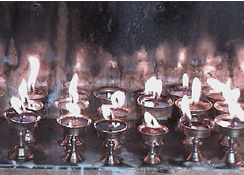 |
Tibetan
butter lamps |
There are several pivotal events in the Buddha’s life that Buddhists celebrate, including his birth, his enlightenment, his first sermon, and his death and release into nirvana. Saga Dawa means ‘fourth month’, and it is on the 15th day of this month on the Tibetan calendar that Tibetan and Nepalese Buddhists celebrate both his birth and the day when he died and attained Nirvana.
Religious observance is influenced and shaped by the culture in which it is practised. During Saga Dawa, people flock to villages and monasteries turning their prayer wheels and singing and dancing. It is also a festival of light, where butter lamps abound. Although picnics are common, as a day of strict Buddhist observance no meat is allowed.
One of the main places of pilgrimage is Mt Kailash, where participants meditate and perform parikrama (circumambulation) around the holy mountain. Mt Kailash, located in the far west of Tibet, is sacred to four great Asian religions—Tibetan Buddhism, Hinduism, Jainism and Bon—and is considered by all to be the axis mundi, the mountain at the centre of the universe around which suns, planets, and moon circle. For humans, it is approximately 58 km around the mountain, a circumambulation that takes one long day for Tibetans—sixteen if prostrating—and three days for less-hardy visitors. The main event of the ceremony is the replacement and raising of Tarboche*, the flagpole which marks the mountain’s position at the centre of the universe. As the pole—festooned with prayer flags—is raised, observers throw thousands of additional paper prayers into the air, along with handfuls of tsampa, barley flour.
It
is said that the month of Saga Dawa is so sacred that any merit obtained
for the performance of a good deed or religious practices (e.g. reciting
of mantras) is doubled. Participants perform prostrations around Buddhist
monuments and some fast or remain silent for a week. Sutras are read at
the monastery and the monks engage in the masked Cham dances—rituals
that are performed for emotional and spiritual purification.